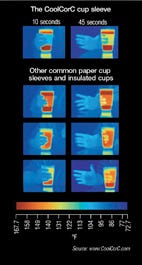January 30, 2014
|
Cork was once the only crown fit for wine. Then the metal screw cap came along, as well as synthetic corks, which have won increasing favor as wine bottle closures. Cork may have found a new ally, however, in the ascendant prince of beverages, coffee. Memphis, TN-based CoolCorC is selling hot beverage cup sleeves made out of cork, rather than paper, and says its alternative is greener and more functional.
Cofounders and brothers Larry and Josh Wright began brainstorming the concept three years ago. “I had been looking at furniture in a design magazine and found some made from cork,” says Larry. “I thought, 'That's really cool. Where the heck does cork come from?'”
A little research revealed to him how sustainable the material is, he says. Cork comes from the outer layer of bark on the cork oak tree and can be stripped off once every nine years, a process said to promote the tree's healthy growth. “We're not cutting down any trees to make this product,” says Larry.
Buying more cork also stimulates the planting of more cork oak trees, which is precisely what the World Wide Fund for Nature urged of top cork producer Portugal this past summer. The environmental group says that expanding the forests would reduce the threat of desert growth the country is facing. Endangered species such as the Iberian Lynx and Iberian Imperial Eagle reportedly depend on the ecosystem nurtured by cork oak trees.
Cool to touch
|
Thermal images of CooolCorC cup sleeve and the competition |
What about utility? “Cork feels good, looks good and is very insulating,” says Larry. “I thought to myself, 'What kind of product would make sense with this material?'”
CoolCorC started in 2006 and has since sold more than a million cup sleeves. “Our product protects your hand a lot better than the paper sleeves, which are just paper on paper,” says Larry. “Even the double-walled cups can still hurt your hand when squeezed because the walls touch each other.”
He also notes that cork's frictional quality lends it a more secure grip, and that it's tough. “It's a very durable product on the cup,” he says.
CoolCorC runs manufacturing facilities in Cincinnati, Memphis and Xian, China. The cork it receives is broken up into an agglomerate, made into sheets, stamped out, cut into sleeves and glued together. CoolCorC uses proprietary equipment, but much of the work is also done by hand.
Unassembled sleeves are available in addition to two different sizes of assembled sleeves, and custom specifications can be met for larger orders. Other capabilities include logo printing.
“We've got a lot of smaller customers, and we're working on some larger ones,” says Larry. “We're also looking hard into the cold beverage market.
“We know that we've got to get the word out,” he continues. “Once people see this, they just hit their forehead and say, 'Why didn't we think of that?'”
About the Author(s)
You May Also Like




